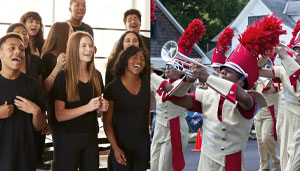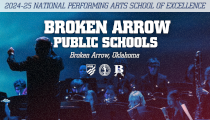Following a Legend — and Creating Your Own
By Christina Pizzino-Catalano on July 19, 2023 music directors & adjudicators article PrintHere’s guidance on how to fill big shoes — and big expectations — when you’re the new teacher on the block.
When I received the letter from my superintendent congratulating me on my preliminary tenure appointment at Niskayuna Central School District in New York State, he took the time to scrawl the following message in the margin: “You followed a legend and created your own.” I blinked, reread the statement, and breathed a sigh of relief to be acknowledged as someone who was carving her own pathway within an already flourishing music program.
The legend I followed, Paula Brinkman, was one of my sponsor teachers just two years prior during my student teaching experience while working toward an undergraduate degree at the Crane School of Music of the State University of New York at Potsdam. Brinkman helped guide me and eased the transition inherent in a school’s bidding farewell to a beloved teacher who was retiring and cautiously welcoming a rookie with high expectations eager to jump headfirst into an established protocol.
As I look back on what scaffolded my success, I thought it might be helpful to share a few tips for those experiencing a similar journey.
- Conquer the basics.
You will already be under watchful eyes since you’re the new kid (teacher) on the block. Your fellow faculty members, administration, parents, the community, and most important, the students who will interact with you have expectations for you. Dress professionally, be punctual (better yet, early), and make yourself approachable by creating an environment of trust and reliability. Keeping detailed attendance, maintaining accurate and current grades, and even jotting down a few notes when hearing a playing exam/audition can save time in the long run if you are ever required to circle back and discuss a student’s progress. Though it may seem simplistic, responding to e-mails and phone calls in a timely manner demonstrates that you are organized and able to handle the rudimentary tasks that are the foundation of being a successful educator.
2. Show yourself to be truly committed.
As a music teacher, you are always on display, whether it is modeling proper technique during rehearsals, conducting performances, or demonstrating your own craft at professional gigs. Give everyone something positive to talk about as you make your presence known within the district. Volunteer to chaperone a school function, attend an after-school sporting event, or carve out an hour to stop by a building/union social to show you are putting forth an effort to be part of the community. People talk, and your visibility (or lack thereof) will be noticed. A wise colleague once advised that when you are a topic of conversation at the dinner table, whether positive or negative, you are being judged. Steer the course toward more of the former by contacting parents with encouraging comments about their son or daughter rather than only reaching out to discuss poor behavior.
3. Choose repertoire wisely.
You still savor the moment when your college select choir performed Morton Lauridsen’s “O Magnum Mysterium” after a mere four rehearsals. The experience meant so much to you that you just have to share this piece with your students. But is it really appropriate for the level of your ensemble? Can you achieve the balance, stellar intonation, and expressive qualities with a group still learning to grasp music fundamentals such as sight-reading, blending within a section, and rich timbre? Will the students feel overwhelmed and frustrated — or, perhaps worse, bored?
Frustration plus boredom equals unwanted discipline problems. In the orchestral vein, if you feel strongly about exposing your group to Sibelius, perhaps giving a polished performance of “Finlandia” will have a more lasting impact than struggling through the third movement of his Symphony No. 2. For band directors really itching to tackle Music for Prague 1968, consider John Krance’s transcriptions from some of the pieces that make up Carmina Burana, which works the extremes of the range of some of the instruments and helps expand students’ endurance, as suggested in Teaching Music through Performance in Band, edited by Richard B. Miles (GIA Publications, 1997).
To motivate your students, repertoire should be age-appropriate, span a multitude of genres, and give students a sense of accomplishment on a daily basis. Using your state’s published manual to peruse repertoire for festivals and evaluations can steer you in the right direction when choosing selections for your group so you can create a unified goal along with a comfortable level of work on musical concepts and techniques. Challenge your students, but be reasonable and realistic when looking to balance a performance program.
4. Foster positive relationships.
Asking families to assist you at an evening event is a great way to get to know who you can count on for support. It is also a good way to build positive relationships. Notice something unique about a student, and offer a compliment. Set up a volunteer opportunity, and work side by side with students outside the school day to get to know more about some of them in a smaller setting, while simultaneously making a difference in the community. If a colleague needs help with something, step in and make a connection. Addressing others by name and introducing yourself shows that you are respectful and attentive. As simple as it may seem, smiling, saying hello, and acknowledging others in the hallways — especially custodial and administrative staff — creates a lasting impression that will be to your advantage. Being present for others is a gift that goes a long way.
Also, make use of your school’s mentoring program. My high school band colleague Eric Hughes, now the director of music education for Niskayuna School District (New York), patiently helped me work through setting up an online gradebook and creating interim report comments for the first time. As my assigned mentor, he guided me through many important duties, including teaching me about the school code of conduct, offering disciplinary advice, showing me some good ways to approach conversations with parents and coworkers, and handling things like proofreading and required paperwork.
5. Rinse, repeat, revise.
Many traditions probably already exist in your district that you may be completely unaware of. Immediately scrapping annual performances is a sure way to attract negative attention. To keep such time-honored traditions alive, don’t be afraid to ask questions of your students, colleagues, supervisor/department chair, and if available and willing, your predecessor. These people are valuable resources who have already experienced such events and can help educate you about what the expectations are as well as about the mechanics of planning and executing such occasions. If you have an idea that might make something more efficient, or a small change that could be exciting, introduce it gently and in a positive light. Publicly complaining about the logistics of a special concert (or even more unprofessional, a colleague who is loved and respected) will create an off-putting buzz that you do not want following you around.
In the age of convenience through technology, a quick email exchange or text message can be all you need to clarify something that will make your life much easier. While my own predecessor was helpful and freely offered advice, in some situations, it may be more appropriate to respect the distance that your predecessor creates. Look for subtle cues that may hint at a need for space or disconnection, and simply use other resources. Be sensitive to your own needs as well by recognizing that perhaps you need your own time and freedom to create a pathway to help you find success in your new position.
6. Reflect.
The best and most effective teachers are reflective in all stages of their career. I under-programmed at my first concert, and while my music director cushioned the blow with a compliment, he was honest in that the timing of the set was too short. I listened earnestly and openly with a desire to improve, then contemplated what I could do to change for the next performance. Finally, I adjusted my approach to develop an end result more in line with the expectations. Taking constructive criticism graciously and molding our practices throughout our careers is important, as we are ever-developing, lifelong learners.
Take this idea one step further by engaging students in the practice of reflection during rehearsals to create an environment of trust and a classroom that is always a work in progress. Something as simple as an anonymous survey with questions such as “which piece did you like best/least this year?” or “what is one thing you would like to change about this course” can be very eye-opening. If students have Internet access via cell phones, laptops, tablets, or similar technology, the website www.surveymonkey.com is a great online tool. For example, you may be shocked to learn many of your students want more sight-reading practice during ensemble classes (who would have thought?) along with some sort of democratic voice in repertoire choices. Over the summer, you can ruminate on ways to implement such valuable requests into the curriculum while maintaining the pace and structure already created. On occasion, you might even spy the ultimate gratification like the following at the end of a survey: “I also wanted to thank you! I have really noticed a change in myself as a musician. So, thank you for pushing me and for giving me opportunities to test and strengthen myself through amazing training.”
Filling the shoes of a previous beloved teacher certainly can be difficult. Those up to the challenge must be willing to approach such a situation with a passion for their subject area, strong content knowledge, a practice that is malleable, and a willingness to grow and develop through reflection. Someday, I hope to be a useful and inspirational resource to whomever will follow in whatever legend I may create in my own classroom and community. While it may be difficult to sever the tie to a long career, I am so thankful that my own predecessor and colleagues have helped me remove the training wheels and have given me the support and encouragement to embark on a journey to help our music program continue to soar.
Christina Pizzino-Catalano
Christina Pizzino-Catalano is director of choral studies at Niskayuna High School in Niskayuna, New York. This article first appeared in NAfME’s Teaching Music Magazine, January 2020 edition. NAfME advocates at the local, state, and national levels; provides resources for teachers, parents, and administrators; hosts professional development events; and offers a variety of opportunities for students and teachers. The Association has supported music educators at all teaching levels for more than a century. Check out NAfME here: (https://nafme.org/)
Most Recent Articles







